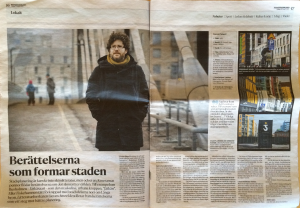Today, the 4th Helsinki Literature and the City Network symposium. Keywords: post-apocalyptic city; urban wilderness and postmodern spatial poetics; city as public space; epiphany; literature and the peripheral city; literary second cities. More here; programme below.
10.15 Welcome Address
10.30-11.30 Petter Skult (Åbo Akademi): ”Periphery versus Centre in the Post-Apocalyptic City”
Sarianna Kankkunen (University of Helsinki): “Urban Wilderness, the City and the Self: Postmodern Spatial Poetics in Maarit Verronen’s Prose Fiction”
11.30 -12.30 Theory Reading
Turmel, Patrick: “The City as Public Space”
Hans Ulrich Gumbrecht: “Production of Presence” (chapters 6-9)
Turmel, Patrick: ‘city as public space’
Hans Ulrich Gumbrecht: ‘Epiphany Presentification Deixis’
12.30-13.45 Lunch Break
14.00-15.30 Literary Second Cities –conference (Åbo Akademi 2015) meeting
Literature and the Peripheral City editorial board meeting


